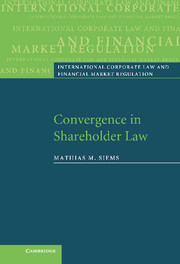Book contents
- Frontmatter
- Contents
- Preface and acknowledgments
- List of abbreviations
- Table of cases
- Table of legislation
- Introduction
- PART I The object and course of the investigation
- PART II The status quo of convergence
- PART III Developmental trends and patterns
- 7 Bases
- 8 Convergence through congruence
- 9 Convergence through pressure
- 10 Future convergences in shareholder law
- 11 Conclusions to Part III
- PART IV Conclusion
- References
- Index
11 - Conclusions to Part III
Published online by Cambridge University Press: 15 December 2009
- Frontmatter
- Contents
- Preface and acknowledgments
- List of abbreviations
- Table of cases
- Table of legislation
- Introduction
- PART I The object and course of the investigation
- PART II The status quo of convergence
- PART III Developmental trends and patterns
- 7 Bases
- 8 Convergence through congruence
- 9 Convergence through pressure
- 10 Future convergences in shareholder law
- 11 Conclusions to Part III
- PART IV Conclusion
- References
- Index
Summary
This study on developmental trends and patterns in shareholder law has highlighted the possibilities and limits of a forecast. On the one hand, it has in principle been possible to show in what way the law will develop further in future (section I below), what convergence forces will be decisive thereby (section II below) and where further areas of convergence in shareholder law will be found (section III below). On the other hand, it has quite commonly been necessary to choose cautious wording (‘likely’, ‘might’ etc.) in order not to fall into false determinism. Although the predictions could be based only on present knowledge, it has also become clear how in general terms one area of commercial law is likely to develop further in the age of globalization.
Re-regulation
Shareholder law is ‘dependent’ in the sense that factual circumstances may spark off reforms of the law. The history of company and securities law shows that legal development is at least also a mirror image of economic factors. This can be further confirmed by the public choice theory, according to which what counts in the political decision-making process is the decision-makers' own interests and the external influence from third parties (especially interest groups). If these factors come closer together, a convergence in law is also likely.
The regulatory levels decisive for this lie basically in national acts of parliament.
- Type
- Chapter
- Information
- Convergence in Shareholder Law , pp. 366 - 370Publisher: Cambridge University PressPrint publication year: 2007

